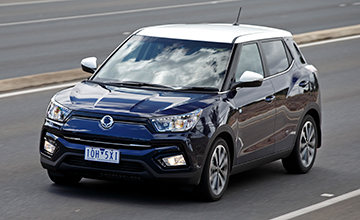
Drive impressions
Tivoli takes on small SUVs, particularly those with a European flavour such as the Peugeot 2008 and Renault Captur, and the Japanese including the Mazda CX-3 and Nissan Juke.
The thing is that although some of these are quite trendy and can turn heads at car parks, they are comparatively tiny.
The Tivoli is bigger in a sense that it fools people into believing it’s a small car yet has Tardis tendencies. It has, for example, room for four adults in sufficient comfort, against say the CX-3 and Juke which will forever lose you friends.
The seating position is comfortable with excellent footwell room – an immediate hint that the right-hand drive Indian market had a part to play – with the very welcome tilt and telescopic steering column just adding the icing.
On top of that, the seat is height adjustable and the driver visibility is very good, while it’s also a welcome place to sit as a passenger.
A clean instrument binnacle with a pair of bright, clear dials, a soft-feel horizontal dash strip that eases the hard plastic dashtop and door cards, neat tray ahead of the front passenger for small items, and good console space are highlights.
Rear seat room suits two adults with good leg- and headroom, structured seats with good support, and a pull-down armrest.
The rear seat can recline slightly for comfort or better placement of a baby seat, and folds flat for the Ultimate variant that has a full-size spare. Other models get a space-saver spare and create a deeper well that won’t allow the boot floor to align with the seat back.
Boot space is a commendable 423 litres but drops to about 350 litres when the full-size spare – and its resulting higher false floor – are added, putting it ahead of the Juke and 2008 but below the Captur.
There are two baby-seat anchors and two Isofix connections to suit family needs, and even if there may not be sufficient boot room for equipment needed for two kids, SsangYong has Plan B – the Tivoli XLV.
This variant retains all the Tivoli features and equipment but adds about 230mm to the length courtesy of an extended tail, and with it has a huge 720L boot that is up 297 litres on the standard-length SUV.
Unfortunately, The XLV was not available for testing at launch, neither was a petrol-engined Tivoli or a manual transmission version.
The diesel automatic carries the weight of the car’s judgement here. Preconceived notions play a role here – it’s a barely-known small SUV made in South Korea with parts from India and under the control of Indian masters – but they are all dispelled within the first 10km on the road.
This is an impressive small SUV in a category not known to impress. The steering is light yet direct, the engine very torquey though a bit gravelly, the chassis feels rigid and the suspension is both supple and yet body roll is minimal.
The six-speed auto from Aisin has been fitted to so many small cars it’s almost the go-to box for the category. In the Tivoli it meets the diesel head on and collaborates almost seamlessly to get the power to the front wheels.
Acceleration is brisk with the surprise being the flexibility and responsiveness. There’s enough cogs in the box to keep the diesel on boil and allow it to punch hard from as low as 1500rpm – the point where its impressive 300Nm first hits.
Most notable is the clean path the SUV can carve through a corner, with minimal fuss and plenty of rigidity felt from the body to ignore rutted bitumen patches and keep the wheels firmly on the ground.
Plenty of seat comfort for the driver works well with the impression that this car could be driven hard for a long time, tiring neither the engine nor the occupants.
The fuel average on this test was 7.1 litres per 100 kilometres, a long way from SsangYong’s claim of 5.5 L/100km but affected here by some enthusiastic driving over conditions not conducive to economy.
Also driven was the diesel all-wheel drive, noted by the “4WD” door badge, in Ultimate guide and with a price tag of $33,990 before on-roads.
The equipment adds things like sunroof and leather upholstery but is designed mainly to appeal to people who need extra traction. The 167mm ground clearance, on-demand all-wheel-drive system (which can be locked into AWD) and a multi-link rear suspension (replacing the 2WD’s torsion beam) are some strengths.
This AWD adds 90kg to the 2WD’s 1390kg weight, and lifts the claimed average fuel consumption to 5.9 L/100km.
On the road it feels more solid, but showed no improvement in handling on the bitumen, suspecting that the engagement of AWD needs some decent loss of traction in the front wheels before biting.
Aside from its driving manners, the Tivoli – in all variants – comes standard with autonomous emergency braking (AEB), forward collision warning, lane departure warning and high beam assist.